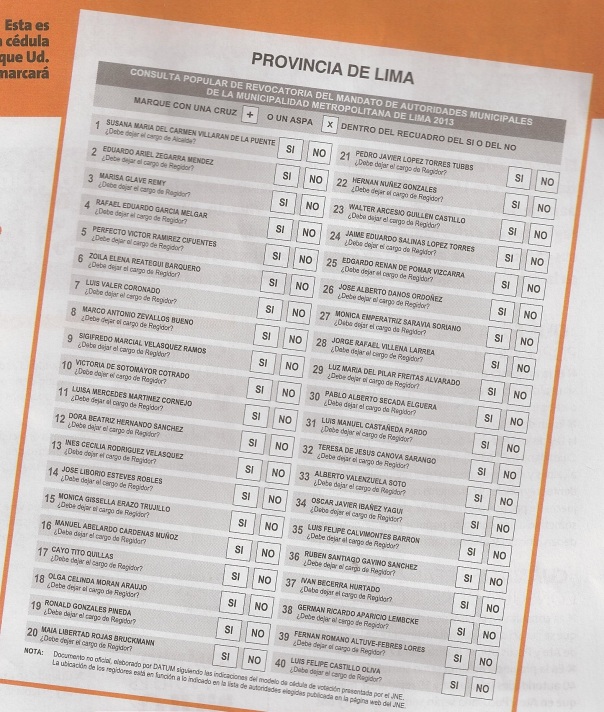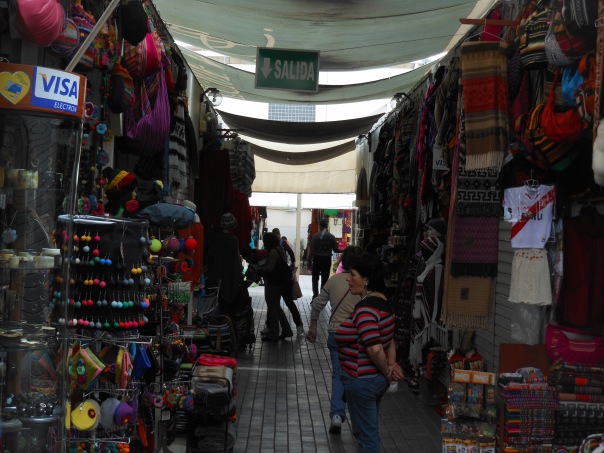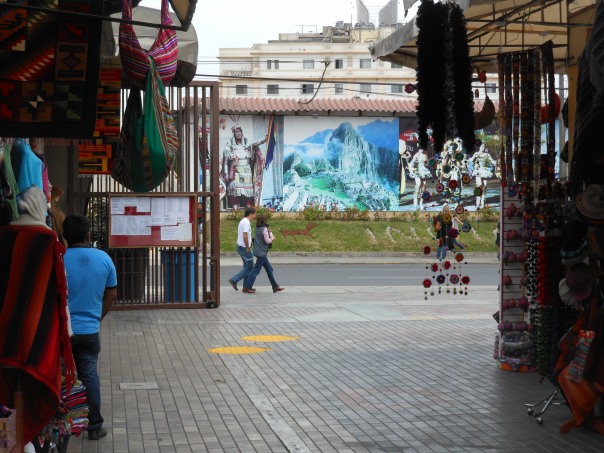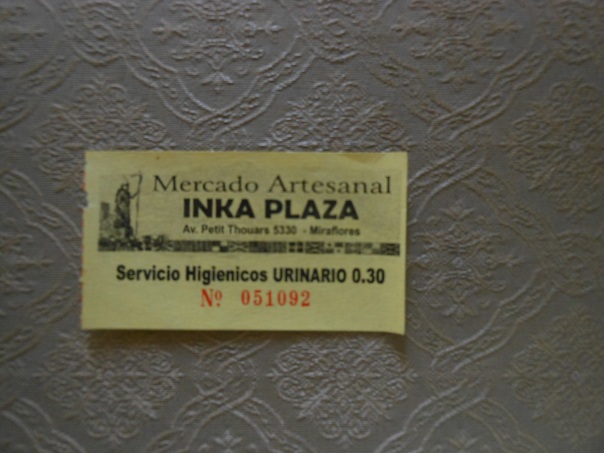Category Archives: Difference
Total Recall – Perhaps
This Sunday, March 17 (which is St. Patrick’s Day, but this seventeenth day of the third month is also the feast days for St. Jan Sarkander, St. Ambrose of Alexandria, and St. Gertrude of Nivelles…just thought you might be interested), the citizens of Lima will go to the polls to decide whether to recall the current mayor, Susan Villaran, and thirty-nine of the city’s regidores (which I think is something akin to members of a City Council).
The ballot that voters will be presented with looks like this…
In case you can’t quite see everything on the ballot, there are forty rows with the name of the mayor (in the #1 spot) and the thirty-nine regidores. Each row has two boxes marked “SI” and “NO”. If a person wants the person recalled (i.e., booted from office), they mark “SI”. If the voter wants the person to stay in office, they mark “NO”. The instructions for the ballot are quite specific. Only an “X” or an “+” mark in the box will be considered a valid selection. No checkmarks, please.
Also of note on the instructions is the warning that there is a S/. 74 fine for those eligible voters who do not vote. At the current exchange rate, that comes out to be about $29. I wonder how a system like that would fly in the United States.
Here’s another fun fact about the election. If the mayor is indeed recalled, there will be an election to choose the next leader of the city. However, in the interim, who will be the head honcho? The answer is the highest regidore who is not recalled. So if the mayor and the top three regidores are all kicked out, then regidore #4 becomes the interim mayor until the next election.
Not quite sure what happens if all forty folk are recalled.
As with any election, there have been some moments of forehead-slapping eye-blinking surrealism.
To start, the spokesperson for the “SI” coalition, Marco Tulio Gutierrez said this last week about the voting populace that was of the female persuasion…
Las damas siempre dicen que no y terminan diciendo que sí, ese es el encanto de las damas.
Roughly translated, his words come out to…
The ladies always say no and end up saying yes, that’s the charm of ladies.
Needless to say, this tone-deaf appeal to women did not go over well. In addition to criticism from women’s groups in Peru, a local cartoonist lampooned Tulio’s comment by drawing him in front of a prison saying his words. In the background, were convicted rapists saying “Without a doubt!”, “That’s right!”, and “It’s so!”
Yesterday (March 10), a televised debate was held between the “SI” and the “NO” groups. Well, actually, only the “NO” people showed up. For some reason, two of the three “SI” folk failed to appear and the only one who did left after giving her opening statement. You can read an article about it here.
Too bad Clint Eastwood wasn’t around. Then he really could have had a honest debate with an empty chair.
With a week to go, I can only imagine it will become stranger.
For Your Consideration
The presenting of the Academy Awards are nigh upon us.
With that in mind, I wanted to take this portion of my blog space and let you know how the names of the nine nominees for Best Picture were translated into Spanish. I have written before (here and here) about the odd twists and turns translations can wreak upon movies, so here we go again.
Of the nine films vying for the Oscar statuette and title of Best Picture, two of the titles underwent no modification. This was probably because they were proper names and those don’t translate too well. Those movies were Argo and Lincoln.
There are a pair of movies that did not have English titles. Here in Peru, for whatever reason, the powers-that-be did not keep the original name and did translate them into Spanish. The first was Les Miserables which is showing at our local Lima cineplex under the name Los Miserables. The second was Amour, which was been rebranded to Amor.
One movie was only slight changed and its translation doesn’t suffer much. Django Unchained was transmogrified into Django Sin Cadenas (Django Without Chains).
The remaining trio of translated titles had their meanings completely shuffled when the name is changed from English to Spanish and back to English.
Zero Dark Thirty became La Noche Mas Oscura (The Darkest Night).
To buy a ticket to see Life of Pi, one has to ask for Una Aventura Extraordinaria (An Extraordinary Adventure).
Bradley Cooper and Jennifer Lawrence do not star in Silver Linings Playbook, but instead top the marquee for Los Juegos Del Destino (The Games of Destiny).
Astute readers will notice that I have only written about eight movies. The final movie vying for the Oscar has not been released in Peru. However, even when the local newspapers write about this movie for their articles about the Academy Awards, the writers do not translate the title into Spanish. For whatever reason, the newspapers refer to this movie by its English moniker, Beasts of the Southern Wild.
If this cinematic gem comes to Peru, I will let you know what title it appears as.
I’d say more, but I fear the music is about to cut me off right about here.
Wheels Within Wheels
I enjoyed our cruise during late-January/early-February. I had a good time seeing landmarks and cities I had never seen before and probably will not be able to view for quite some time. The photos of those places will wait until another post because I wanted to highlight an interesting aspect of being on a vessel mainly composed of folks who conversed in Portuguese.
I live in Peru and I have a difficult enough time as it is speaking and understanding Spanish. I have written before about how I view my brain as having a translation engine where the Spanish word goes in, the cranks, wheels, and gears turn, and the output that pops through my head is the word in English.
When I had to chat with the Brazilian crew or passengers, my engine developed another layer.
When I heard or read a word in Portuguese, I found I was translating the word into its closest Spanish equivalent. From that Spanish approximation, my regular translation engine would kick in and I could then understand the word.
If I may provide a minor, yet illuminating, example, it is the Portuguese word Atenção. I knew from experience that the suffix –ção was equivalent to the Spanish ending of –cion. So the word now became Atencion, which I knew was the Spanish word for “Attention”. Good to know as a sign that had Atenção on it was something I wanted to be aware of.
Other than the usual exhaustion one feels after a relaxing vacation, I was doubly-tired from having my translation engine work overtime.
Considering the experience of other cruise passengers over the same time period in a different body of water, I can’t complain too much.
Nowhere near Kansas
As mentioned in yesterday’s post, the family and I went on a nine-day cruise off the eastern shoreline of South America. We started in Brazil and in fact the majority of the passengers and a large portion of the crew were from that large country.
That last sentence was just the set-up for this query…
How can you tell you are on a Brazilian ship?
Because when the Super Bowl was being held on February 3 while we were at sea, the cruise line did not broadcast the game between the Ravens and the 49ers. No TV anywhere on the floating vessel – not in the cabins, not in the sports bar, not on the giant video screen by the pool – showed the teams coached by the Brothers Harbaugh battling it out.
However, a few days later, when Brazil played England in a friendly soccer game…that contest was shown on every available screen. Even the giant video display by the pool.
By the way, England won 2-1 much to the dismay of 98% of the passengers.
Now Available in White
Day 493 – November 26, 2012
My lack of Spanish has left me scratching my head over what I’m sure is an interesting story I read in a newspaper.
In this Monday’s weekly section of El Comerico called Dia_1, there is a small sidebar story with the simple headline of Toyota vende autos blancos (Toyota sells white cars).
I’m not quite sure why it’s big news (or even small news) that a Japanese car company is offering the color white as an option for its vehicles. To my mind, white seems to be a fairly standard hue (examples are here and here and here).
The Dia_1 article had a picture of a white Toyota with the caption Retorna el color de la paz (Return of the color of peace).
The word “return” would mean, to me, that the color of white was once available in Peru and then, for whatever reason, was taken off the market.
I had hoped the actual story would answer my questions as to why white was once a taboo color in cars and why it has now come back. However, I was disappointed as my less-than-perfect translation of the article did not satisfy my curiosity. Here is the text…
La compania Toyota del Peru ha retornado la venta de vehiculos de color blanco en el pais. Segun expertos en marketing, la marca japonesa descontinuo en los ultimos anos este color de su portafolio de productos, como una manera de evitar que la mala reputaction de los autos de timon cambiado de esa marca contagie a los de timon original. Ahora que se ha prohibido la importacion de autos usados con timon a la derecha, nuevamente se haria viable la venta de autos Toyota del color de la paz.
This is the translation that Google Translate provided me…
The company Peru Toyota has returned to selling white cars in the country. According to marketing experts, the Japanese discontinued in recent years this color of its product portfolio, as a way to prevent the bad reputation helm of cars changed from getting to that brand of original rudder. Now that it has banned the import of used cars with the right rudder, this again makes feasible the sale of Toyota cars of the color of peace.
What appears to be throwing me is the Spanish word timòn which Google translates to “helm” but can also mean “rudder”, “tiller”, or “wheel”.
So did Toyota stop selling white vehicles in Peru because of some unfortunate event in the past that tainted the opinions of Peruvians towards carros blancos? Does white have some sort of cultural red line that Peruvians did not want to cross?
This article in microcosm exemplifies my experience as a non-native Spanish speaker living in a country where English is rarely spoken. When people speak to me or when I read articles in newspapers and articles, I feel as if I have only understood the tippiest tiniest part of the linguistic iceberg. There is so much more nuance and meaning that I am missing that I can only wonder what lies beneath.
Some days it’s missing out on why white cars are back on sale and some days it’s missing out on why and how people feel the way they feel.
As a parting note, if anyone has a better translation of the above story or knows why white was once a verboten tint, please feel free to drop a thought in the comment section.
Gracias
Road Reading
Day 528 – December 31, 2012
As New Year’s Eve moves into New Year’s Day, I wanted to take this opportunity to share with you one last observation I had about living in Peru for 2012.
This nugget about life in Peru came while at a stoplight one morning a few weeks ago. Looking around at all of the other cars, it dawned on me that none of the privately owned vehicles had any bumper stickers. After having that realization and after realizing that I was basing my judgement on only one point in space and time, I began to take notice of the bumpers of all the other cars around me.
Sure enough, my initial impression was correct: The vast mass majority of Peruvian drivers (at least in Lima) do not have bumper stickers on their vehicles. Because of this absence, I am at a loss to determine who is a proud parent of what honor roll student, what the driver’s other car is, what they would rather be doing than driving, or what their political preference is.
The sole exception to this gross generalization are the taxis, but only then the bumper stickers that adorn these compact cars are advertisements for local radio stations.
The other sole exception (“other sole”…sounds like that came from the Department of Oxymorons) is that some privately owned cars have the decals on their back window that show their particular combination of dad, mom, kids, and/or pets. I only bring it up so I can link to this funny (IMHO) comic from xkcd.
And with that…I wish you a happy and healthy dos-mil-trece (It’s how you say the year “2013” in Spanish).
Like the Fourth in December
Day 521 – December 24, 2012
“Like Christmas in July” is a phrase common in the United States.
Down here in Peru, that phrase can be turned on its head because for the past few weeks it has felt like “The Fourth in December”…as in the Fourth of July.
Here is what has been transpiring over the past twenty-four days…
…there have been newspaper articles documenting police raids on companies selling illegal fireworks;
…there have been other stories in newspapers telling their readers which are the safest fireworks to buy; and
…vendors on the street have been selling all manner of pyrotechnics – from individual things that go boom to shrink-wrapped packages that contain about twenty explosives;
All of this firework-related news and commerce is due a Peruvian tradition that begins tonight.
The carol “Silent Night” has no meaning in Peru because when midnight strikes tonight and Christmas Eve moves into Christmas Day, citizens all over the country light off their trove of fireworks.
We were in Cusco last year when the rockets went off. I am curious to see what time I will be able to finally drift off to sleep here in the larger city of Lima with all the bombs bursting in air.
Finally, and tho’ it’s been said many times, many ways….
Feliz Navidad and to all a good (and quiet) night.
XVI-rony
Day 511 – December 14, 2012
I know Peru is a majority Roman Catholic country. This is not a surprise to me.
Given that The World Almanac and Book of Facts 2012 says that eighty-one percent of population follows that faith (page 823) and twenty-two percent of people in the United States are Roman Catholic (as of 2010 / page 607 and 699); and
Given that in Peru workers receive the day off and students miss school due to holidays such as Santa Rosa de Lima Day (August 30), All Saints Day (November 1), and Immaculate Conception (December 8) and workers and students do not receive those days off in the United States; and
Given that many parks in the area have statues devoted to saints and even for a Pope and (as far as I could ascertain) few parks in the United States have similar shrines; and
Given that in December in Peru many public spaces contain Nativity scenes (such as this one in Parque Kennedy)…
…and messages of “Merry Christmas” (or “Feliz Navidad” considering the local language) without raising an eyebrow…
…while in the United States such displays are parties to judicial decisions or rallies;
With all those givens, I was fully acclimated to the fact that Peru was a Roman Catholic country.
Because of that acclimation, I was completely taken by surprise by a satirical drawing I saw in the editorial cartoon section, known as El Otorongo, of the Peruvian newspaper Peru 21. I had thought that as a Roman Catholic country, all aspects of that faith would be treated with respect.
I was wrong.
Translation…
Pope Benedict XVI:
Yes, Pepito [a common name for a young boy], Jesus walked on water.
Yes, Pepito, Jesus multiplied the loaves.
Yes, Pepito, Jesus resurrected the dead.
Pepito (via computer):
And is it true that the world will end on December 21?
Pope:
Not so, Pepito. How can you believe such nonsense?
As dissimilar as our two countries may be concerning the display of the Nativity in public spaces, it was interesting to see that our two nations share a tradition of poking people in power.
When You Gotta Go, You Gotta Pay
Day 492 – November 25, 2012
Today was a shopping day as the family hiked (okay, we drove) it down to the Miraflores area of Lima and wandered around one of markets. Our mercado of choice for today was Inka Plaza. This shrine to buying housing all manner of objects for the tourist to remember his or her visit to Peru. Stall are crammed full of alpaca shawls, T-shirts, chess sets, silver, jewelry, and other assorted items.
Here, look for yourself…
However, this post is not meant to be a quaint retrospective about our mercantile visit. Instead, I wanted to draw your attention to a tiny facet of living in Peru.
During our shopping sojourn, the call of nature came upon me and I detached myself from the vendors and sellers to find the facilities. For those of you journeying to Peru for the first time, you should be aware that the letters SS.HH. are what you are looking for if you need a lavatory (or “loo” for those of your reading on the other side of the Pond). Those letters stand for Servicio Higiencios which could be translated literally as “Hygiene Services”…which is a good enough name for restroom if you ask me.
To borrow a turn of phrase from one of the members of the Fellowship of the Ring, One does not simply walk into a SS.HH. No, one must engage in a transaction and pay for the privilege.
Outside the SS.HH. in the Inka Plaza (and the same thing has occurred me to at Lima’s main zoo), there is a desk with an attendant. Before entering, I had to tell this individual standing guard outside the SS.HH. why I needed to use the facilities. I had to be direct and tell him exactly the mode of relief I needed because the price is different depending on whether I needed to stand or sit. After making my wishes known, I was presented with an admission ticket…
Thirty centavos (about eleven cents) is a small price to pay for relief.
Mixed Messages
Day 502 – December 5, 2012
This story is why I think it’s important for a major metropolitan area to have more than a single newspaper serving its citizenry.
Today’s front page of Peru21 had a tease about a story with this lead, “Peru es el pais mas inseguro de las Americas” (Peru is most unsafe country in the Americas). The article, on page 7, references a study from Barometro de las Americas detailing how Peru, when measuring for violence and corruption, comes in twenty-sixth out of the twenty-six countries that comprise South America and Central America and also includes the United States and Canada.
Meanwhile…
Today’s front page of Publimetro has a picture of a beautiful panaroma of the Malecon area of Lima. The photograph has the caption, “…nuestra capital ocupa puesto 12 en America Latina entre las mejores ciudades para vivir.” (…our capital occupies the 12th spot for the best cities to live in in Latin America) and directs the reader to page 6. Once there, the article mentions the 2012 Quality of Living survey from Mercer. Peru’s capital city is ranked globally at number 121 out of 460 measured cities.
Feeling good or feeling bad about your city of residence (or any other matter) may sometimes depend on what paper you picked up.







